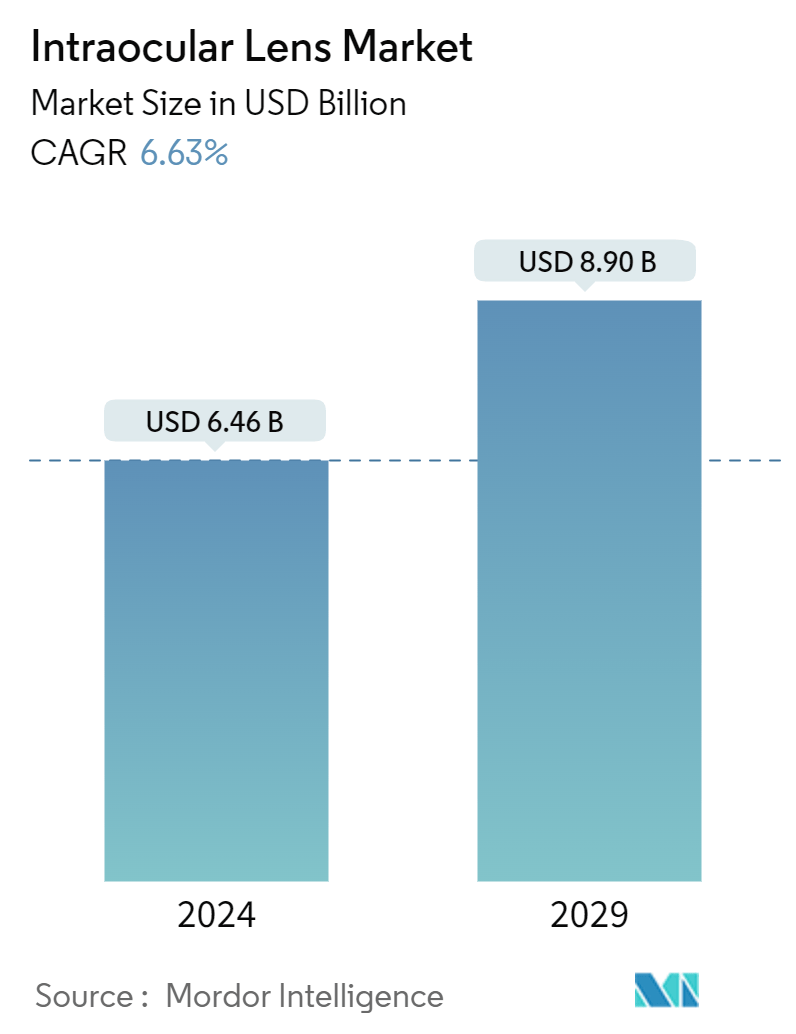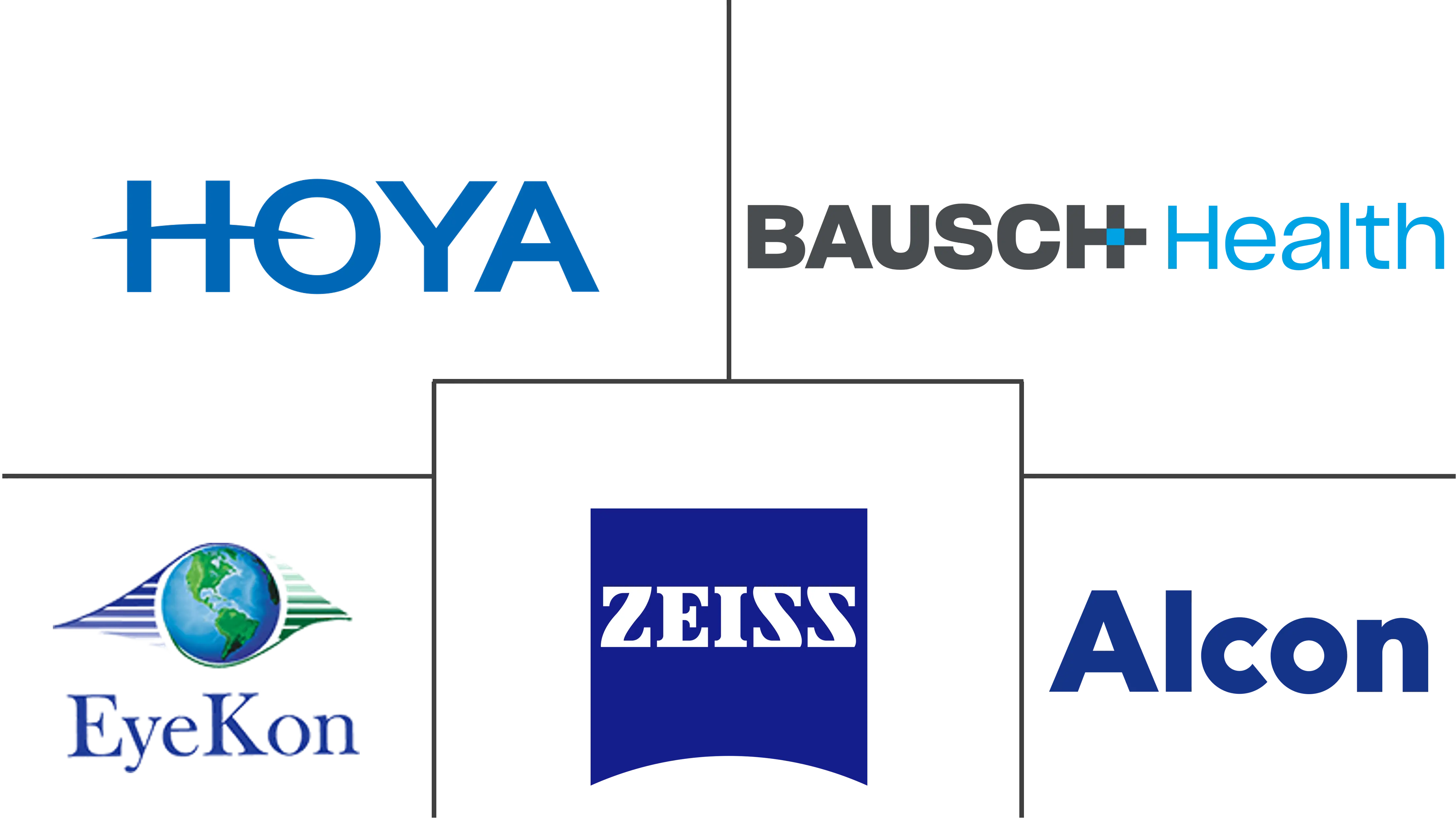Market Size of Intraocular Lens Industry

| Study Period | 2019 - 2029 |
| Market Size (2024) | USD 6.46 Billion |
| Market Size (2029) | USD 8.90 Billion |
| CAGR (2024 - 2029) | 6.63 % |
| Fastest Growing Market | Asia-Pacific |
| Largest Market | North America |
Major Players
*Disclaimer: Major Players sorted in no particular order |
Need a report that reflects how COVID-19 has impacted this market and its growth?
Intraocular Lens Market Analysis
The Intraocular Lens Market size is estimated at USD 6.46 billion in 2024, and is expected to reach USD 8.90 billion by 2029, growing at a CAGR of 6.63% during the forecast period (2024-2029).
Key factors propelling the intraocular lens market include increasing ophthalmic issues, growing cases of cataracts in the diabetic population, and rising adoption of advanced premium IOLs. For instance, as per the RANZCO Pre-Budget Submission 2022-2023, the estimated prevalence of glaucoma in Australians over 50 years is 2.2%. The prevalence of glaucoma in Australia is expected to increase to 379,000 patients by 2025. Therefore, a rise in eye diseases is likely to increase the demand for intraocular lenses and drive market growth.
Increasing awareness about eye diseases and related complications is likely to boost the adoption of intraocular lenses. For instance, in July 2022, as part of the Avoidable Blindness Program (ABP), Novartis and the Fred Hollows Foundation launched the Integrated Eye Health Program for blindness prevention in Kenya. It improves access to eye health services for the most vulnerable and marginalized communities. The program focuses on glaucoma, diabetic retinopathy, and cataracts. For 2022, the partnership’s ambitious goal was to have over 400,000 community members educated in eye health and approximately 40,000 patients screened.
The growing aging population significantly contributes to rising incidences of chronic diseases. As the proportion of older individuals increases, so does the demand for presbyopia treatments. For instance, per the UN Population Fund statistics 2023, the share of the population aged 65 and older was estimated to be around 19.2% of the total UK population in 2023. Hence, the significantly high percentage of the elderly population in the country is likely to increase the risk of age-related eye diseases, driving the market over the forecast period.
In September 2022, Rayner publicized that two highly respected surgeons from the UK had performed the world's first implantations of RayOne EMV Toric. RayOne EMV Toric is the toric variant of Rayner's popular RayOne EMV enhanced monofocal IOL that was developed in collaboration with Professor Graham Barrett. Thus, such product launches and strategic activities are expected to contribute to the market growth during the forecast period.
Owing to the increase in the number of ophthalmic issues and eye diseases in product launches and approvals, the demand for intraocular lenses is likely to rise during the forecast period. However, the increasing costs of IOLs and poor reimbursement coverage are expected to hamper market growth over the forecast period.
Intraocular Lens Industry Segmentation
As per the scope of the report, an intraocular lens is implanted in the eye as part of a treatment for cataracts or myopia. Several types of intraocular lenses are available in the market to improve vision.
The intraocular lens market is segmented by product, end user, and geography. By product, the market is segmented into monofocal intraocular lens, accommodative intraocular lens, multifocal intraocular lens, and toric intraocular lens. By end user, the market is segmented into hospitals, ambulatory centers, and other end users. By geography, the market is segmented into North America, Europe, Asia-Pacific, the Middle East and Africa, and South America. The report also covers the estimated market sizes and trends for 17 different countries across major regions globally. The report offers the value (USD) for all the above segments.
| By Product | |
| Monofocal Intraocular Lens | |
| Accommodative Intraocular Lens | |
| Multifocal Intraocular Lens | |
| Toric Intraocular Lens |
| By End User | |
| Hospitals | |
| Ambulatory Centers | |
| Other End Users |
| By Geography | ||||||||
| ||||||||
| ||||||||
| ||||||||
| ||||||||
|
Intraocular Lens Market Size Summary
The intraocular lens market is poised for significant growth, driven by an increasing prevalence of ophthalmic conditions such as cataracts and glaucoma, particularly among the aging population. The rising incidence of these eye diseases, coupled with the growing diabetic population, is expected to boost the demand for intraocular lenses. The market is also witnessing a surge in the adoption of advanced premium intraocular lenses, which are gaining popularity due to their enhanced features and benefits. Initiatives like the Avoidable Blindness Program in Kenya, aimed at improving access to eye health services, further underscore the increasing awareness and demand for eye care solutions. Technological advancements and strategic product launches, such as Rayner's RayOne EMV Toric and Alcon's Clareon Monofocal, are expected to contribute to market expansion, offering innovative solutions to address various vision-related issues.
North America is anticipated to hold a substantial share of the intraocular lens market, driven by the high prevalence of vision-related disorders and the rapid adoption of new healthcare technologies. The region's market growth is supported by the presence of major players and continuous product innovations, such as Alcon's Clareon Vivity and AcuFocus's IC-8 Apthera IOL. The market's semi-consolidated nature sees significant activity in mergers and acquisitions, as companies strive to expand their revenue share and diversify their product offerings. Despite challenges like high costs and limited reimbursement coverage, the market is expected to grow, fueled by the increasing demand for intraocular lenses and the ongoing development of advanced eye care solutions.
Intraocular Lens Market Size - Table of Contents
-
1. MARKET DYNAMICS
-
1.1 Market Overview
-
1.2 Market Drivers
-
1.2.1 Increasing Ophthalmic Issues and Eye Diseases in the Diabetic Population
-
1.2.2 Increasing Cases of Cataract in the Diabetic Population
-
1.2.3 Rising Adoption of Advanced Premium IOLs
-
-
1.3 Market Restraints
-
1.3.1 High Cost of IOLs
-
1.3.2 Lack of Reimbursement Policies
-
-
1.4 Porter's Five Forces Analysis
-
1.4.1 Threat of New Entrants
-
1.4.2 Bargaining Power of Buyers/Consumers
-
1.4.3 Bargaining Power of Suppliers
-
1.4.4 Threat of Substitute Products
-
1.4.5 Intensity of Competitive Rivalry
-
-
-
2. MARKET SEGMENTATION (Market Size by Value - USD)
-
2.1 By Product
-
2.1.1 Monofocal Intraocular Lens
-
2.1.2 Accommodative Intraocular Lens
-
2.1.3 Multifocal Intraocular Lens
-
2.1.4 Toric Intraocular Lens
-
-
2.2 By End User
-
2.2.1 Hospitals
-
2.2.2 Ambulatory Centers
-
2.2.3 Other End Users
-
-
2.3 By Geography
-
2.3.1 North America
-
2.3.1.1 United States
-
2.3.1.2 Canada
-
2.3.1.3 Mexico
-
-
2.3.2 Europe
-
2.3.2.1 Germany
-
2.3.2.2 United Kingdom
-
2.3.2.3 France
-
2.3.2.4 Italy
-
2.3.2.5 Spain
-
2.3.2.6 Rest of Europe
-
-
2.3.3 Asia-Pacific
-
2.3.3.1 China
-
2.3.3.2 Japan
-
2.3.3.3 India
-
2.3.3.4 Australia
-
2.3.3.5 South korea
-
2.3.3.6 Rest of Asia-Pacific
-
-
2.3.4 Middle East and Africa
-
2.3.4.1 GCC
-
2.3.4.2 South Africa
-
2.3.4.3 Rest of Middle East and Africa
-
-
2.3.5 South America
-
2.3.5.1 Brazil
-
2.3.5.2 Argentina
-
2.3.5.3 Rest of South America
-
-
-
Intraocular Lens Market Size FAQs
How big is the Intraocular Lens Market?
The Intraocular Lens Market size is expected to reach USD 6.46 billion in 2024 and grow at a CAGR of 6.63% to reach USD 8.90 billion by 2029.
What is the current Intraocular Lens Market size?
In 2024, the Intraocular Lens Market size is expected to reach USD 6.46 billion.

